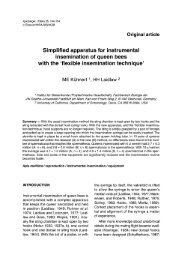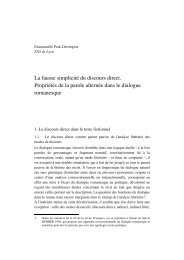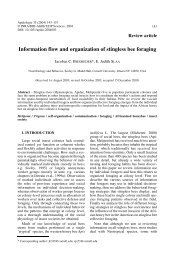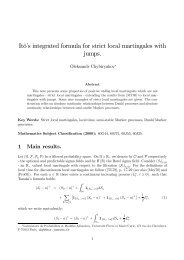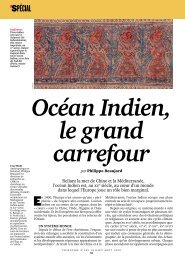ARBEITSGEMEINSCHAFT DER INSTITUTE FÜR ... - HAL - INRIA
ARBEITSGEMEINSCHAFT DER INSTITUTE FÜR ... - HAL - INRIA
ARBEITSGEMEINSCHAFT DER INSTITUTE FÜR ... - HAL - INRIA
Create successful ePaper yourself
Turn your PDF publications into a flip-book with our unique Google optimized e-Paper software.
gezogen werden, daß nicht alle artspezifisch variierenden Komponenten des Larvenfuttersaftes<br />
nach diesem Prinzip evolutiv verändert wurden.<br />
SUMMARY<br />
Caste differentiation in meliponine bees. Comparative analyses of larval<br />
food under the aspect of balanced nutrit’ion<br />
Studies on the trophogenic basis of caste differentiation in honey bees have<br />
led to the almost general acceptance of a concept which regards « balanced<br />
nutrition » as an important presupposition for the differentiation of queen specific<br />
characters. In order to evaluate this concept for caste differentiation in<br />
stingless bees comparative analyses were carried out on the composition of larval<br />
food from 7 meliponine species (Scaptotrigona depilis, Scaptotrigona bipunctata,<br />
Nannotrigona testaceicornis, Partamona cupira, Tetragonisca angustula, Plebeia<br />
droryana and Melipona quadrifasciata). The larval food from freshly provisioned<br />
worker cells was analysed for the following parameters : water content, content<br />
of reducing sugars and total protein including the free amino acid and protein<br />
fractions. The water content in the different types of larval food amounted to<br />
40-60 % and the sugar content made up 5-14 % of the fresh weight. The protein<br />
content revealed a strong divergence of the group Scaptotrigona/Nannotrigona<br />
from the other species. Free amino acids amounted to 0.14-1.3 % of the fresh<br />
weight. With respect to the free amino acid composition in the larval food, the<br />
7 species differed greatly from each other. The polypeptide pattern (SDS-PAGE)<br />
of the larval food types revealed 5 bands which the 7 species had in common<br />
from a total of 28 bands. The protein patterns from the larval food of the two<br />
closely related species S. depili.s and S. bipunctata could hardly be distinguished,<br />
while Melipona larval food differed from the trigonine pattern by the almost<br />
general lacking of polypeptides of higher molecular weights (40-80 Kd). For a<br />
comparative discussion of the larval food composition, under the aspect of<br />
« balanced nutrition », distance matrices were calculated for the two parameters<br />
free amino acid composition and polypeptide pattern. From these matrices<br />
minimal distance trees were constructed and could be compared to phylogenetic<br />
trees from classical taxonomic work on stingless bees (M OURE , 1951, 1961 ;<br />
WILLE , 1979). The degree of conformity between the minimal distance trees<br />
and the phylogenetic tree can be discussed as a measure for a species-specific,<br />
selected larval food composition. The minimal distance tree for the amino acid<br />
composition in the larval food of the 7 species was completely incongruent with<br />
the phylogenetic tree, while the minimal distance tree for the protein pattern<br />
coincided with the latter. Thus, it appears to be problematic to speak generally<br />
of a « balanced composition of the larval food of stingless bees. It certainly




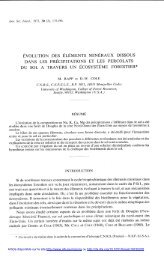
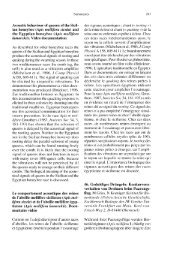
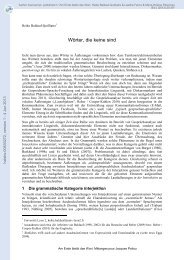
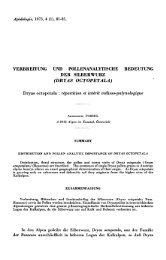
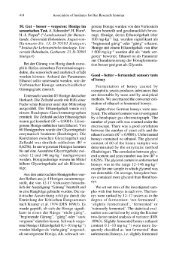
![4 C]-Polyethylenglykol bestimmt, der - HAL - INRIA](https://img.yumpu.com/22454280/1/177x260/4-c-polyethylenglykol-bestimmt-der-hal-inria.jpg?quality=85)
